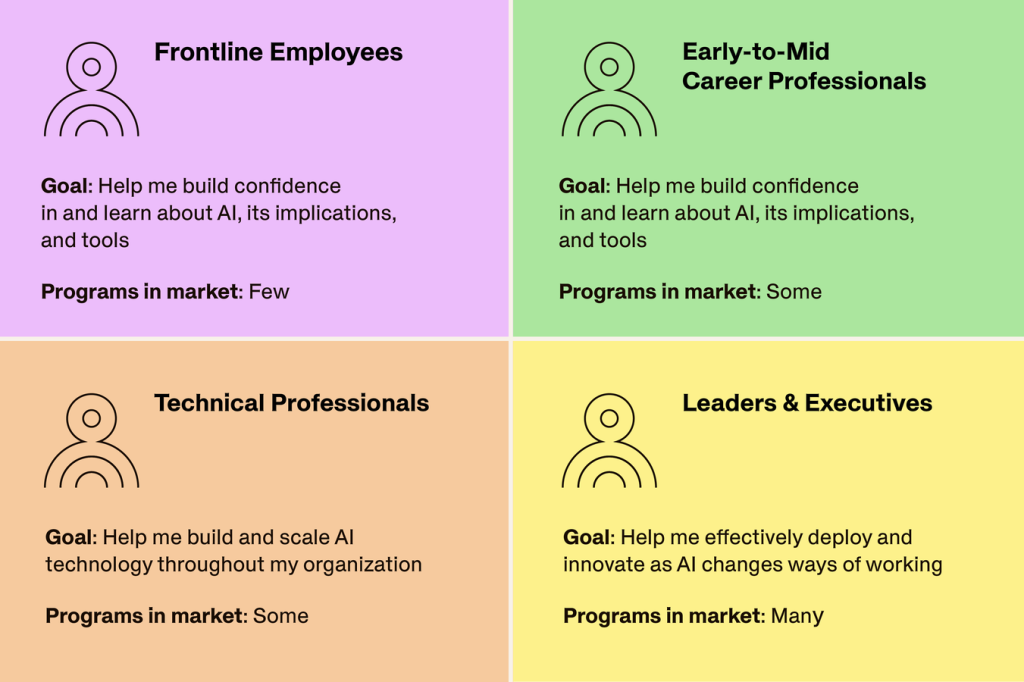*note: the title of this article was written by Guild’s internal GPT
Automation of all kinds is transforming work—with as much as 30% of the work people do today potentially being done by a machine in the near future. And for even a casual reader of the news, it would be impossible to miss the fact that generative AI is a big part of this transformation.
Unlike robotics and many kinds of software-based automation, however, generative AI (as of now) isn’t expected to take jobs so much as join people in their work as a co-pilot. And if AI is going to work alongside us, that means we need to be prepared to work alongside it.
That’s as true for frontline workers as it is for the C-suite.
American workers know this. Six in 10 say that they’ll need to gain new skills because of the impact of AI, and a third think they’ll need to do so in the next year. But there are almost no AI programs in the market for workers without bachelor’s degrees — who make up the majority of all workers and more than 80% of the frontline workforce, which totals 112 million people.
Instead “desk” workers who already have a college education are piling into AI programs. Over the past 12 months at Guild, we’ve seen an eight-fold increase in the number of people applying for courses and programs in AI, and the vast majority of them hold a bachelor’s or higher.
Guild’s research on the landscape has shown that more than half of the available education programs require a bachelor’s degree and they’re designed for either engineers or executives. There’s very little for the non-tech professional, much less frontline workers. That has to change.
To understand the need for a wider range of education options, it’s helpful to have a framework for organizing AI learning needs. We structure it like this:
- AI Fundamentals: Focuses on AI literacy, ethics, and implications.
- AI in Practice: Teaches how to understand and use AI tools.
- AI Expertise: Covers building and scaling AI technologies in the business environment.
- AI for Leaders: Instructs on creating and implementing strategies for AI in business.
These needs can be applied across a whole range of worker-learners, with the most relevant four being frontline workers, early- to mid-career professionals in nontechnical roles like marketing and project management, engineers and other technical professionals, and both tech and non-tech executives.
The existing higher education market is best-suited to address AI education needs of tech professionals and executives because there are structures and incentives in place to serve these audiences.
There are far fewer options in the higher education market for professionals in nontechnical roles, especially those who don’t have bachelor’s degrees—and less natural incentive for colleges to create them. And higher education has exceedingly little to offer in the way of AI education for frontline workers without degrees.
That is bad for equity and for the bottom line.
It sets up a world in which frontline and professional workers without degrees only fall further behind those who have them. It puts frontline workers in fields like customer service and logistics in a particularly precarious position. Their roles are especially vulnerable to being eliminated by automation, and the ones that survive are almost certain to require some facility with robots and AI.
In other words, they have almost no options for remaining up-to-date—and they’re highly likely to lose their jobs in the not-so-distant future if they aren’t. And there also are exceedingly few programs in AI designed for helping frontline workers transition into new roles.
In the immediate, this reality will make companies far less productive and competitive. AI tools can help frontline workers in everything from healthcare to logistics work more efficiently. AI’s potential impact on customer service, in particular, is enormous. Chatbots can now handle many routine inquiries, freeing up workers to focus more on complex problems or on improving the overall customer experience.
IKEA’s Billie chatbot, for example, can now handle almost half of all customer issues—so two years ago, the company started transitioning 8,500 call center workers to interior design advisors. They invested heavily in education and training. Now, sales through those remote designers total $1.4 billion to revenue.
Those gains would have gone unrealized, though, if those frontline employees hadn’t been educated on how to do their jobs differently. Instead, the rise of Billie the bot would have set up the distinct possibility of mass layoffs and workforce turbulence that no forward-thinking company should want.
More companies need to step up, but so too do universities and other training providers. That’s why a partnership between Guild and universities on AI learning bundles, among other recent advancements, show such promise.
“It is more important than ever that institutions of higher education are innovating in real time to ensure our students are leaving the classroom with the necessary skills to compete in the future of work,” said Paul LeBlanc, President of Southern New Hampshire University.
But we need far, far more.
If the prognosticators are right that we’re all going to need to work alongside AI, then we need training for the many, not just the fortunate few.
Read the full article here










